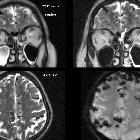CSF rhinorrhea

CSF
rhinorrhea: non-contrast CT, contrast-enhanced CT cisternography or combined?. Non-contrast CT with bone window in coronal and sagittal planes (A and B) show bony defect (3 mm) at roof of right compartment of sphenoid sinus (white arrow), CT cisternography in coronal plane (C) show CSF active contrast leak through that bony defect (black arrow) into the right sphenoid sinus (D), right frontal sinus (E) and right nasal cavity (F)

CSF
rhinorrhea: non-contrast CT, contrast-enhanced CT cisternography or combined?. Non-contrast CT in coronal plane (A) shows defect in left cribriform plate of ethmoid (white arrow), CT cisternography in coronal and axial planes (B&C) show: contrast leak through left cribriform plate of ethmoid (black arrow) (B) to the left nasal cavity and left sphenoid sinus (arrowhead and star) (C). Note previous left middle turbinectomy, partial excision of nasal septum, minimal mucosal thickening of both maxillary sinuses and mildly deviated nasal septum to the right side (A and B)

CSF
rhinorrhea: non-contrast CT, contrast-enhanced CT cisternography or combined?. Non-contrast CT with bone window in coronal plane (A) shows no bone defect, CT cisternography in coronal and sagittal planes (B and C, respectively) show: CSF contrast leak into the right ethmoidal sinus (white arrow). Note mild bilateral mucosal thickening of both maxillary sinuses, left nasal septum spur and mildly deviated nasal septum to the left side

CSF
rhinorrhea: non-contrast CT, contrast-enhanced CT cisternography or combined?. Non-contrast CT in coronal (A), CT cisternography in coronal (B), sagittal (C) and axial (D) planes show defect measuring 6 mm in the roof of the right ethmoid sinus (white arrow) (A and B) with evidence of contrast leak through this defect in addition to herniated brain tissue from the right frontal lobe (black arrow) (C and D)

Non-allergic
rhinitis: a case report and review. Preoperative CT scan of the head. A preoperative CT scan of the head with intrathecal contrast was done to localize the CSF leak. The frontal view is shown here. The scan shows a defect in the cribriform plate with confluent CSF extension into several bilateral ethmoid air cells, evidenced by the higher intensity signal of the contrast. Secondarily, there is mucosal thickening in the ethmoid and maxillary sinuses.

CSF
rhinorrhea • CSF rhinorrhea - CT cisternography - Ganzer Fall bei Radiopaedia

CSF
rhinorrhea • CSF rhinorrhea - Ganzer Fall bei Radiopaedia

CSF
rhinorrhea • Spontaneous cerebrospinal fluid rhinorrhea with pneumocephalus - Ganzer Fall bei Radiopaedia

CSF
rhinorrhea • CSF rhinorrhea from encephalocoele secondary to pseudotumor cerebri - Ganzer Fall bei Radiopaedia

CSF
rhinorrhea • Intrasphenoidal encephalocele (CT cisternography) - Ganzer Fall bei Radiopaedia

CSF
rhinorrhea • CSF rhinorrhea - Ganzer Fall bei Radiopaedia
CSF rhinorrhea refers to a symptom of cerebrospinal fluid (CSF) leakage extracranially into the paranasal sinuses, thence into the nasal cavity, and exiting via the anterior nares. It can occur whenever there is an osseous or dural defect of the skull base (cf. CSF otorrhea).
Pathology
Etiology
- congenital
- meningocele
- encephalocele / nasal encephaloceles
- persistent craniopharyngeal canal
- acquired
- traumatic: closed head trauma with an anterior base of skull fracture is the most common cause of CSF rhinorrhea ; natural barriers between the anterior cranial fossa and paranasal sinuses can be disrupted, leading to rhinorrhea, depending on the severity of trauma
- iatrogenic
- multiple neurosurgical procedures involving the skull base, e.g. transsphenoidal pituitary surgeries
- complex operations at the skull base
- otolaryngology procedures such as septoplasty and endoscopic surgery
- non-traumatic
- spontaneous: chronic elevated intracranial pressure (pseudotumor cerebri) with medial sphenoid meningocele formation
- tumors: malignant nasopharyngeal and skull base tumors invading or involving the skull base can cause CSF rhinorrhea
Anatomical locations
- cribriform plate: it is the most common site for spontaneous CSF rhinorrhea
- sphenoid: occur at the perisellar region and the lateral recess of the sphenoid sinus
- temporal bone and middle ear: common sites are the tegmen tympani and tegmen mastoideum
Radiographic features
CT
- large osseous defects can be visualized on plain CT
- CT cisternography is the diagnostic modality for diagnosing an occult site of CSF leak. It is performed after injecting contrast into the theca; however, this procedure is highly dependent on patient positioning and timing
MRI
- 3D high-resolution T2W and T1W sequences are useful in diagnosing this condition
- coronal reformations can depict the osseous defects with a greater degree of accuracy
Nuclear medicine
- radionuclide studies have higher sensitivity in diagnosing leaks but have poor anatomic resolution
History and etymology
Leakage of spinal fluid into either the nose or the ear was first described as a pathologic entity in 1899 by Sir St Clair Thomson .
Siehe auch:

 Assoziationen und Differentialdiagnosen zu Rhinoliquorrhoe:
Assoziationen und Differentialdiagnosen zu Rhinoliquorrhoe:
